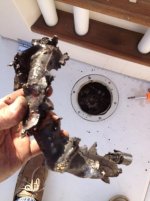Moonfisher1
New member
Hello to all, I've worked on boats for years but this one has me stumped. I have a 1985 Grady White 227 22' Seafarer with a 200 HP Mercruiser 305 2bbl mated to an Alpha One. It ran fine the year before last. I replaced the lower half of the outdrive last spring and tested it with a 20 minute run in the river. Worked fine, put boat on trailer and never used it again last year. I put Stabilizer in the tank with about 1/4 tank fogged the engine and winterized engine/outdrive. This spring, I put in two bottles of dry gas (as usual) changed the Cap and Rotor and fuel/water separator. From my slip, I start the engine and let warm up. I back out and drive about 1/2 mile at 6 Knots to open water. Once there, I WOT for about 20-30 seonds and the boat bogs down and dies. I emptied the fuel water separator 4 times in a 20 minute test run. I can idle fine but the boat dies with the RPMs at or above 3000 for 20-30 seconds. I've gone to a larger 10 micron fuel water separator and installed a rebuilt carb but neither helped. I was about to change out the fuel pump but I don't have a pressure gauge to see if it has 3-6 psi. I haven't checked the anti-siphon valve or the tank pick up screen yet. I ran the boat with the tank cap off so it is not the vent. I did have a bees nest under the helm that I sprayed with wasp killer and I'm wondering if I've corroded an ignition circuit? After the boat stalls out, it restarts instantly. It doesn't matter if the seas are calm or rough. It does the same every time. 20-30 seconds of WOT then stalls or looses 90% power but still idles. I'm planning to try a hose and an alternative source of fuel tomorrow to eliminate the fuel tank as a culprit. I do not think there is any way the newly rebuilt lower unit could be a factor. Any and all comments welcome. Thank you.


